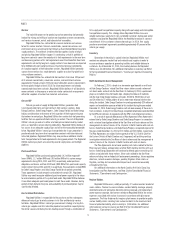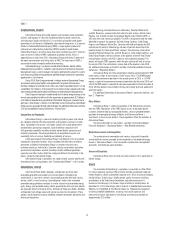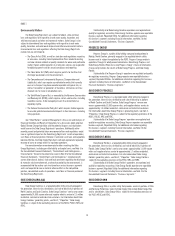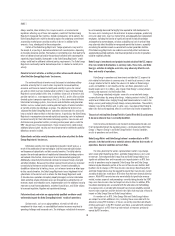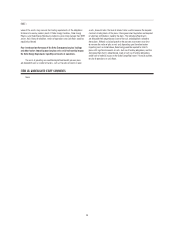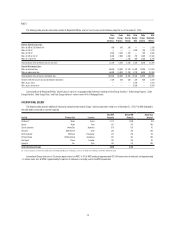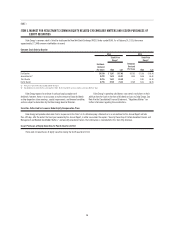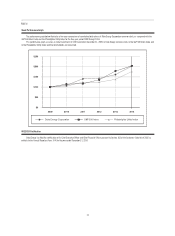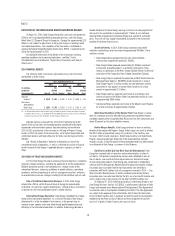Duke Energy 2014 Annual Report Download - page 39
Download and view the complete annual report
Please find page 39 of the 2014 Duke Energy annual report below. You can navigate through the pages in the report by either clicking on the pages listed below, or by using the keyword search tool below to find specific information within the annual report.
PART I
19
NUCLEAR GENERATION RISKS
Duke Energy Carolinas, Duke Energy Progress and Duke Energy Florida may
incur substantial costs and liabilities due to their ownership and operation
of nuclear generating facilities.
Ownership interest in and operation of nuclear stations by Duke Energy
Carolinas, Duke Energy Progress and Duke Energy Florida subject them to
various risks. These risks include, among other things: the potential harmful
effects on the environment and human health resulting from the operation
of nuclear facilities and the storage, handling and disposal of radioactive
materials; limitations on the amounts and types of insurance commercially
available to cover losses that might arise in connection with nuclear operations;
and uncertainties with respect to the technological and fi nancial aspects of
decommissioning nuclear plants at the end of their licensed lives.
Ownership and operation of nuclear generation facilities requires
compliance with licensing and safety-related requirements imposed by the
NRC. In the event of non-compliance, the NRC may increase regulatory
oversight, impose fi nes, and/or shut down a unit, depending upon its
assessment of the severity of the situation. Revised security and safety
requirements promulgated by the NRC, which could be prompted by, among
other things, events within or outside of the control of Duke Energy Carolinas,
Duke Energy Progress and Duke Energy Florida, such as a serious nuclear
incident at a facility owned by a third party, could necessitate substantial
capital and other expenditures, as well as assessments to cover third-party
losses. In addition, if a serious nuclear incident were to occur, it could have a
material adverse effect on the results of operations and fi nancial condition and
reputation of Duke Energy Carolinas, Duke Energy Progress and Duke Energy
Florida.
LIQUIDITY, CAPITAL REQUIREMENTS AND COMMON STOCK RISKS
The Duke Energy Registrants rely on access to short-term borrowings and
longer-term capital markets to fi nance their capital requirements and
support their liquidity needs. Access to those markets can be adversely
affected by a number of conditions, many of which are beyond the Duke
Energy Registrants’ control.
The Duke Energy Registrants’ businesses are fi nanced to a large degree
through debt. The maturity and repayment profi le of debt used to fi nance
investments often does not correlate to cash fl ows from their assets. Accordingly,
as a source of liquidity for capital requirements not satisfi ed by the cash fl ow
from their operations and to fund investments originally fi nanced through debt
instruments with disparate maturities, the Duke Energy Registrants rely on
access to short-term money markets as well as longer-term capital markets.
The Subsidiary Registrants also rely on access to short-term intercompany
borrowings. If the Duke Energy Registrants are not able to access capital at
competitive rates or at all, the ability to fi nance their operations and implement
their strategy and business plan as scheduled could be adversely affected.
An inability to access capital may limit the Duke Energy Registrants’ ability to
pursue improvements or acquisitions that they may otherwise rely on for future
growth.
Market disruptions may increase the cost of borrowing or adversely
affect the ability to access one or more fi nancial markets. Such disruptions
could include: economic downturns, the bankruptcy of an unrelated energy
company, capital market conditions generally, market prices for electricity and
gas, actual or threatened terrorist attacks, or the overall health of the energy
industry. The availability of credit under Duke Energy’s Master Credit Facility
depends upon the ability of the banks providing commitments under the facility
to provide funds when their obligations to do so arise. Systematic risk of the
banking system and the fi nancial markets could prevent a bank from meeting
its obligations under the facility agreement.
Duke Energy maintains a revolving credit facility to provide backup for
its commercial paper program and letters of credit to support variable rate
demand tax-exempt bonds that may be put to the Duke Energy Registrant
issuer at the option of the holder. The facility includes borrowing sublimits
for the Duke Energy Registrants, each of whom is a party to the credit facility,
and fi nancial covenants that limit the amount of debt that can be outstanding
as a percentage of the total capital for the specifi c entity. Failure to maintain
these covenants at a particular entity could preclude Duke Energy from issuing
commercial paper or the Duke Energy Registrants from issuing letters of credit
or borrowing under the Master Credit Facility.
The Duke Energy Registrants must meet credit quality standards and
there is no assurance they will maintain investment grade credit ratings.
If the Duke Energy Registrants are unable to maintain investment grade
credit ratings, they would be required under credit agreements to provide
collateral in the form of letters of credit or cash, which may materially
adversely affect their liquidity.
Each of the Duke Energy Registrants’ senior long-term debt issuances is
currently rated investment grade by various rating agencies. The Duke Energy
Registrants cannot ensure their senior long-term debt will be rated investment
grade in the future.
If the rating agencies were to rate the Duke Energy Registrants below
investment grade, borrowing costs would increase, perhaps signifi cantly.
In addition, the potential pool of investors and funding sources would likely
decrease. Further, if the short-term debt rating were to fall, access to the
commercial paper market could be signifi cantly limited. A reduction in liquidity
and borrowing availability could ultimately impact the ability to indefi nitely
reinvest prospective undistributed earnings generated by Duke Energy’s foreign
subsidiaries, which could result in signifi cant income taxes that would have a
material effect on its results of operations.
A downgrade below investment grade could also require the posting of
additional collateral in the form of letters of credit or cash under various credit,
commodity and capacity agreements and trigger termination clauses in some
interest rate derivative agreements, which would require cash payments. All
of these events would likely reduce the Duke Energy Registrants’ liquidity and
profi tability and could have a material effect on their fi nancial position, results of
operations or cash fl ows.
Non-compliance with debt covenants or conditions could adversely affect
the Duke Energy Registrants’ ability to execute future borrowings.
The Duke Energy Registrants’ debt and credit agreements contain
various fi nancial and other covenants. Failure to meet those covenants beyond
applicable grace periods could result in accelerated due dates and/or termination
of the agreements.
Market performance and other changes may decrease the value of
the NDTF investments of Duke Energy Carolinas, Duke Energy Progress
and Duke Energy Florida, which then could require signifi cant additional
funding.
Ownership and operation of nuclear generation facilities also requires the
maintenance of funded trusts that are intended to pay for the decommissioning
costs of the respective nuclear power plants. The performance of the capital
markets affects the values of the assets held in trust to satisfy these future
obligations. Duke Energy Carolinas, Duke Energy Progress and Duke Energy
Florida have signifi cant obligations in this area and hold signifi cant assets in
these trusts. These assets are subject to market fl uctuations and will yield
uncertain returns, which may fall below projected rates of return. Although
a number of factors impact funding requirements, a decline in the market


